Officially, then, here is the new “near-production” seventh-generation Golf GTI. Rather that resummarise the info we brought you yesterday here’s all you need to know about the new Golf VII GTI in dot point form:
- One GTI, two power levels
- EA888 series 2.0 litre turbocharged engine
- Standard: 162kW (220PS)/350Nm
- Performance Pack: 169kW (230PS)/350Nm
- 0–100km/h: 6.6s (6.5s Performance Pack)
- 80–120km/h: 5.0s (4th); 6.0s (5th)
- Brakes: 16″ with red painted callipers (17″ Performance Pack)
- Tyres: 225/45/17 (225/40/18 optional)
- Wheels: Denver, Detroit, Glendale, Brooklyn (17″ or 18″)
- Top speed: 246km/h (250km/h Performance Pack)
- Fuel consumption: 6.0l/1ookm (with 6-speed manual)
- CO2 emissions: 140g/km
- Front axle differential lock (VAQ)—Performance Pack only
- Progressive steering
- 15mm lower ride height
- Meets EU6 emissions standards
- Stop/Start system
- Bi-xenon headlights
- LED foglights
- Smoked LED rear lights
- Twin 80mm chrome tail pipes
- Three-spoke flat bottomed steering wheel
- Model specific instrument cluster with colour display
- Sport seats (with sliding drawers underneath)
- “Clark” tartan fabric
- European launch in early 2013
That pretty much sums everything up. Although, we’re a little unsure if we should read anything into the fact there’s been no mention or confirmation of the rumoured 100kg weight loss. Perhaps that level of detail will come when the GTI is launched next year.
UPDATE: A selection of pics from the floor of the Paris Motor Show have been added below, with thanks to GolfMk7.com. We recommend you follow this link and check out their full gallery.
Paris 2012 – Golf GTI concept car – initial facts
Volkswagen shows near-production concept of the seventh Golf GTI:
Sporty icon is available with two power levels for first time
- New Golf GTI produces 220 PS in standard version and 230 PS with performance pack
- Production version of seventh Golf GTI debuts with new progressive steering
Wolfsburg / Paris, 27 September 2012
Paris is now the city of the Golf GTI. Four years ago, the sixth generation of the best-seller made its debut here – still as a concept car. Now, in autumn 2012, Volkswagen is presenting the seventh generation Golf GTI in a premiere at the Mondial de l’Automobile in Paris ï€ also as a concept car. In doing so, Volkswagen is opening another window to the immediate future of the most successful European car model series, because another car being shown to a global audience in the French capital at the same time as the GTI is the near-production concept of the new Golf BlueMotion. The new Golf GTI will be launched into the market in early 2013.
One GTI, two power levels
220 PS and 230 PS. The concept of the next Golf GTI is powered by a further advanced engine from the EA888 series – a two-litre turbocharged direct-injection petrol engine with 162 kW / 220 PS. A new option: for the first time in the iconic sports car’s history, a performance pack will be available as a factory-installed option. In this version, the engine’s maximum power is boosted to 169 kW / 230 PS. Both GTI versions are equipped with a Stop/Start system as standard, they fulfil the EU-6 emissions standard that takes effect in 2014 and – with a 6-speed manual gearbox – they attain the same low DIN fuel consumption of 6.0 l/100 km (CO2: 140 g/km). Compared to the previous model (155 kW / 210 PS), the combined fuel consumption of the new Golf GTI is therefore reduced by 1.3 litres per 100 km or 18 per cent. A 6-speed dual-clutch gearbox (DSG) is available as an option for both power levels. The recognised high agility of the Golf GTI has been increased once again in the new model compared to the previous model – in two stages:
Stage 1 – standard GTI: The 220 PS base version now produces 10 PS more than the previous model. At the same time, its maximum torque was increased by an immense 70 Nm to 350 Nm. This value in the new Golf GTI is exactly the same as that of the previous Golf R, which was powered by an engine from another TSI generation. Equipped in this way, the Golf GTI makes its appearance with impressive flexibility values: in fourth gear, the Golf GTI accelerates from 80 to 120 km/h in 5.0 seconds; in fifth gear it takes 6.0 seconds. Other data that must not be overlooked in a GTI: the new one accelerates to 100 km/h in 6.6 seconds and reaches a top speed of 246 km/h.
Stage 2 – Performance GTI: Those choosing a Golf GTI with the performance pack ignite the second stage. As mentioned, the car’s power is increased by 10 PS here, while its maximum torque is identical. The 230 PS of power enables a top speed of 250 km/h* and just 6.5 seconds for the sprint to 100 km/h.
New front axle differential lock and progressive steering
The performance pack not only offers a plus in power, but also a plus in handling: instead of 16-inch brakes, the GTI is equipped with 17-inch brakes here (with GTI badges on the callipers) and a front axle differential lock (VAQ) that is also being offered for the first time in this form.
Front axle differential lock. The electronically controlled lock has a positive effect on active safety and driving dynamics, because it practically prevents the power-related understeer that can occur in powerful front-wheel drive cars. This makes handling precise, and has a stabilising effect in load-alteration induced oversteer. The reason: VAQ increases the power to the wheel on the outside of the curve, which also optimises the vehicle’s speed through bends. Traction is also improved when driving on loose and wet road surfaces and in turning situations.
Progressive steering. The new progressive steering system is celebrating a world premiere in the Golf GTI. It is a standard feature for both power levels. Thanks to this steering system, the driver can turn the car through a desired radius with fewer turns of the steering wheel. In other words, the driver does not need to reach over the wheel as often. That may sound simple, but it is revolutionary. The reason is that conventional steering systems work with a constant gear ratio. The new steering of the Golf GTI, meanwhile, operates with a progressive steering gear ratio. This noticeably reduces steering work when manoeuvring and parking. On country roads with lots of bends, and when making turns, the driver experiences a benefit in dynamics due to the more direct layout.
Technically, progressive steering differs from the basic steering system due to the rack and pinion’s variable tooth spacing and a more powerful electric motor. Its functional difference: unlike with constant steering ratios, which by necessity always represent a compromise between dynamic performance and comfort, here the steering rack’s toothing is significantly modified by the steering stroke. As a result, the transition between indirect steering behaviour in the mid-range (straight-line driving) and direct steering behaviour at larger steering wheel angles is designed to be progressive, which, as mentioned above, enables significantly more agile steering behaviour in dynamic driving situations. This results in smaller steering input angles when parking for greater convenience and comfort.
Variable ratios have long been known in the area of hydraulic steering systems; however, the tuning of such a steering system is subject to very tight limits, so that the driver is not overtaxed by the transitional behaviour. With the Golf GTI’s progressive steering system the situation is completely different: the combination of the steering rack’s progressive steering ratio and the tuning potential of an electro-mechanical steering system is systematically exploited in the GTI to realise optimised steering behaviour that is sporty yet practical in everyday driving. In all other Golf cars, progressive steering is offered as an optional feature.
Exterior – features and styling
GTI insignia. Like all six Golf GTI generations before it, the seventh generation concept car being shown in Paris is distinguished from other Golf models by numerous additional equipment features and classic GTI insignia. On the exterior, these include the red painted brake callipers, a GTI-typical honeycomb structure for the air inlet screens, smoked LED rear lights including LED licence plate lighting as well as chrome 80 mm diameter tailpipes on the left and right. Some features have been characteristic since the days of the first Golf GTI, for example the production colours Red (“Tornado Redâ€) and “Black†and an optional white exterior (“Pure White†as special colour). Volkswagen has further developed the classic GTI wheels “Denverâ€, “Detroit†and “Glendale†whose styling characteristics from the previous model have flowed into the design of the new machine-polished 17-inch “Brooklyn†alloy wheels; they have a lighter visual look and are in fact lighter in weight. The wheels are fitted with 225/45 size tyres. 18-inch wheels will also be available on the GTI as an option.
GTI styling. Overall, the seventh generation Golf is also visually more dynamic than the previous one. The objective of the designers was to develop an even more striking and sporty character into the new Golf GTI – the goal was to give the GTI a lower, wider image with a more challenging character. Volkswagen Design developed numerous individual, detailed solutions for the new Golf GTI and integrated them harmoniously into the overall visual concept. Important here is the fact that the GTI-specific design elements are not simply “add-on†solutions, but are integrated into the overall design of the car. One significant reason for this is that the GTI was designed in parallel to the “normal†Golf – and this made it possible to coordinate perfectly the differentiating characteristics of the two model versions.
At the front end, with its LED fog lights specially customised for the GTI, a powerful and significant GTI element attracts attention, which has now been fully reinterpreted: the red stripe. In the first generation of the car it surrounded the rectangular radiator grille completely. On the sixth generation GTI there were two red stripes, which framed the grille at the top and bottom. Now, on the seventh generation car, the red stripe marks the lower edge of the radiator grille, but for the first time it extends further to the left and right, up to the housings of the bi-xenon headlights. So, the red line now runs completely across the front end.
In the far lower section of the bumper, beneath the crossbar painted in body colour, the black air inlet (with a honeycomb pattern screen) is no longer framed by a black area, rather by surfaces painted in body colour, which makes the air inlet stand out more powerfully. At the same time, the three lateral black aerodynamic fins beneath the headlights play a more prominent role in the front end styling. Another detail fitting in with the precisely contoured styling is the black splitter (lower edge of the front spoiler), which is familiar from motorsport. Also styled in black are the side sills and the rear diffuser. These quasi wrap-around black elements give the Golf, which is equipped with a GTI sport chassis (15 mm lower ride height), an even fuller stance on the road.
Another example of the harmonious integration of GTI-specific elements is the new roof spoiler design, which is considerably larger than its counterpart on Golf versions with less powerful engines and which is integrated to be flush with the bootlid and the body. For the first time, the sporty Volkswagen also has ï€ in addition to the GTI badges at the front and rear ï€ red plates on the front wings at the height of the character line with the same typographic interpretation of the GTI logo that has been used for decades.
Interior – features and appearance
GTI insignia in the interior. The very first GTI had this feature: seat covers in legendary tartan pattern. The sixth generation Golf GTI used “Jacky†fabric, and in the transition to the new GTI generation this has been redesigned and is now named “Clarkâ€. Naturally, the tartan pattern was retained. The sport seats (in front, with sliding drawers under the seats) have exceptionally good ergonomic properties. Step in, sit down, adjust the backrest angle and the distance to the steering wheel, buckle up, and you’re all ready to drive. Nonetheless, the front seats also have height adjustment and a manually adjustable lumbar support. Red decorative seams in the area of the seats and the gear shift trim provide a sporty contrast; the black roofliner that is always part of the GTI emphasises the sporty layout of the interior.
GTI features. Along with its many standard features such as air conditioning, fatigue detection and the “Composition Touch†radio system (with CD card slot and AUX-IN interface), other GTI-specific features refine the standard version interior as well: typical of a Golf GTI are the customised sport steering wheel and a special gear shift grip. The latter is once again reminiscent of a golf ball, which also makes it a tribute to the first GTI just like the new leather-trimmed steering wheel design. The sporty flat-bottomed steering wheel with its three metal spokes and trim in high-gloss black has a lightweight look, and it is remarkably handy and easy to grip. On its two cross spokes it has multifunction keys as standard, and at its centre ï€ in contrast to all other Golf steering wheels – it has a round impact absorber whose form is similar to that of the component in the first GTI.
Also making a strong statement is the GTI instrument cluster with a colour display and independent graphics of its instruments. It is no coincidence that it resembles high-end chronographs. The GTI-specific look of the interior is completed by red ambience lighting, special trim strips and panels (trim strips in the front doors with ambience lighting), brushed stainless steel pedals and foot rest (on left), door sill entry plates in front with a stainless steel application and ambience lighting that is also integrated here.
* Forecast value
TDI, TSI, DSG and Twincharger are registered trademarks of Volkswagen AG or other companies of the Volkswagen Group in Germany and other countries. Features and technical data apply to models offered in Germany. They may differ in other countries. All fuel consumption and CO2 data cited are forecast values as of September 2012.
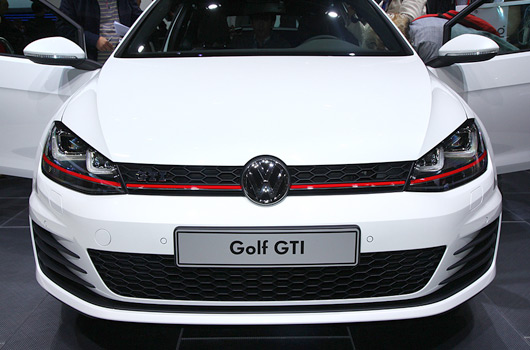
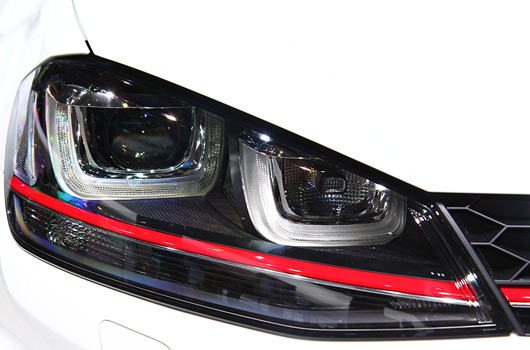
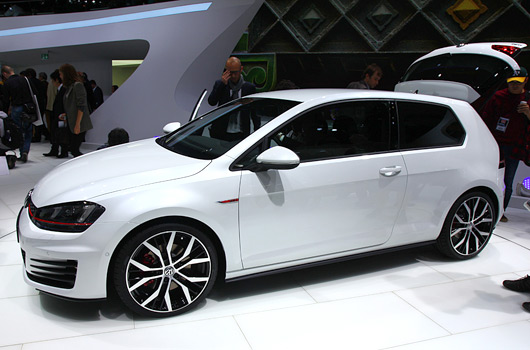
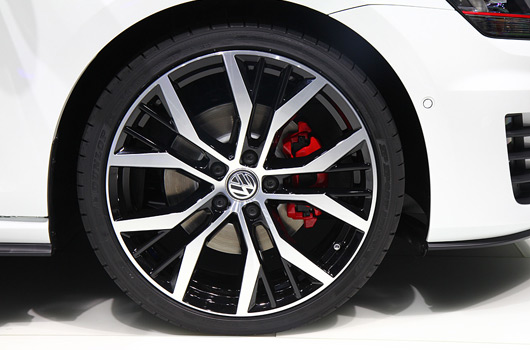
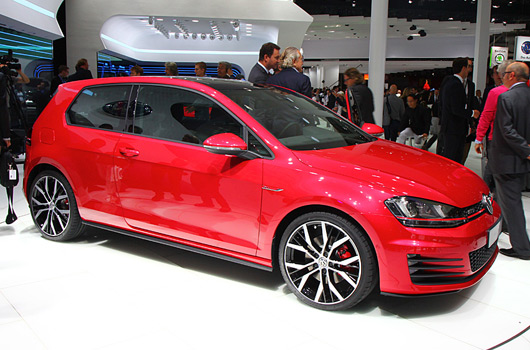
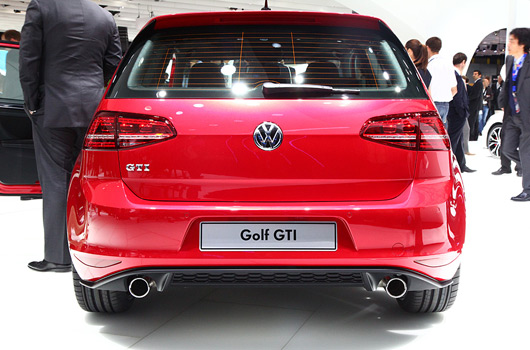
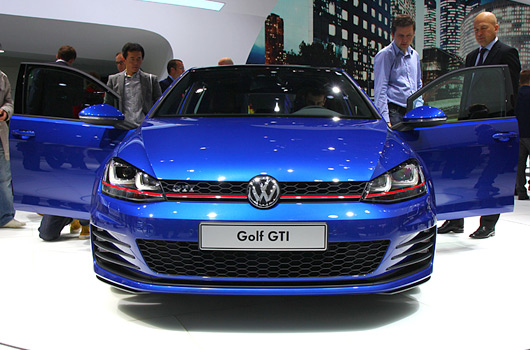
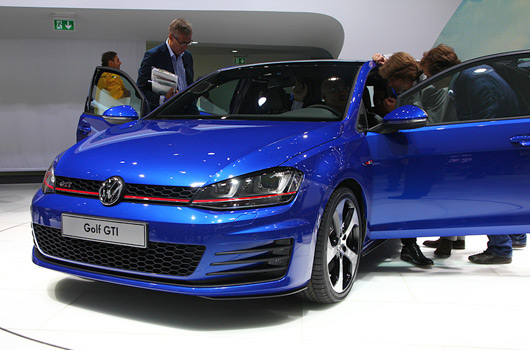
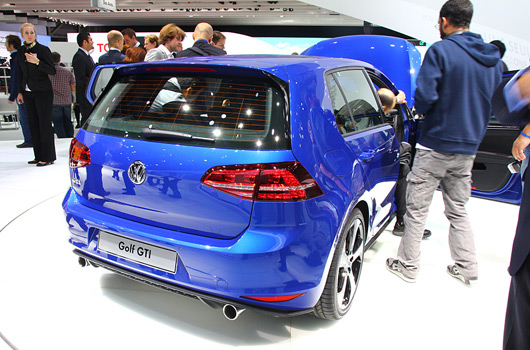
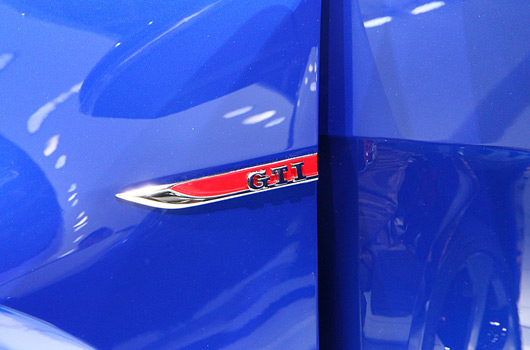
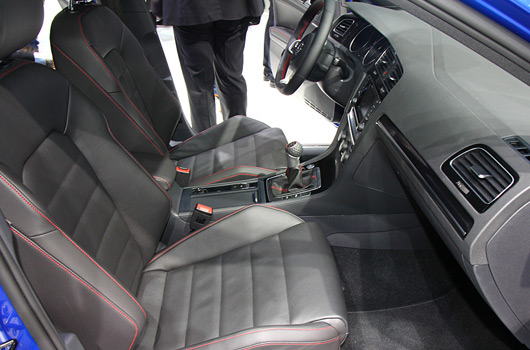
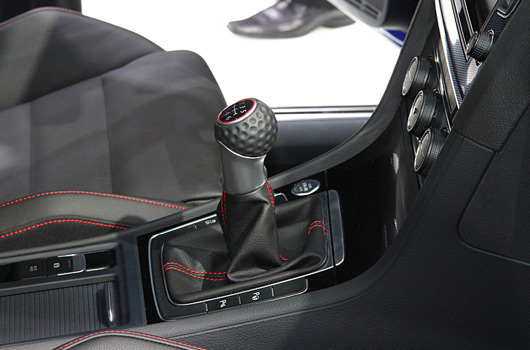
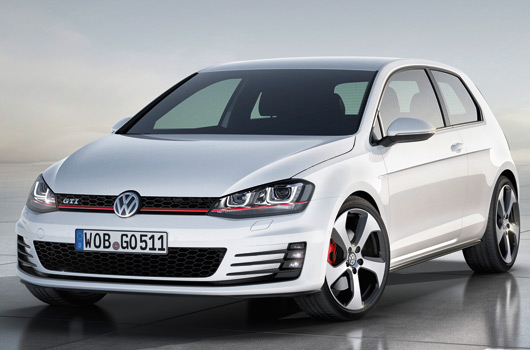
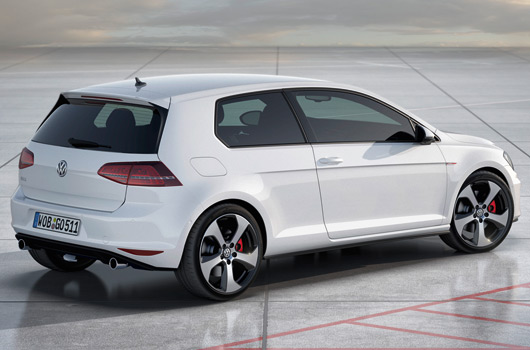
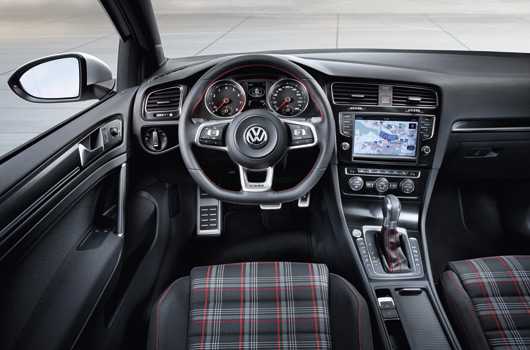
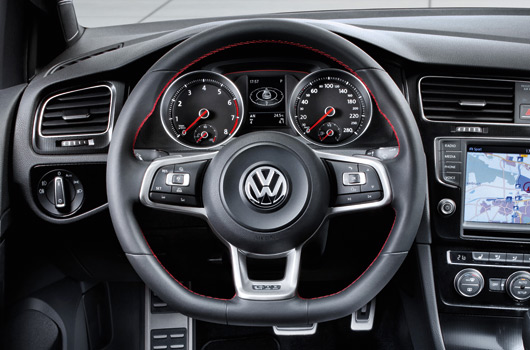

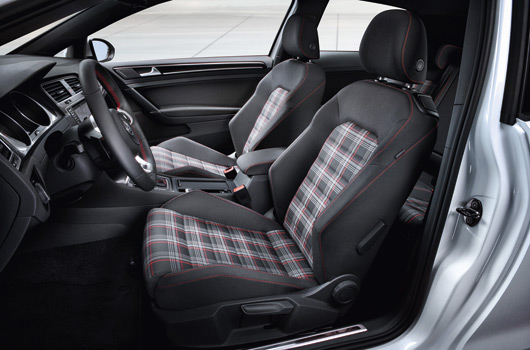
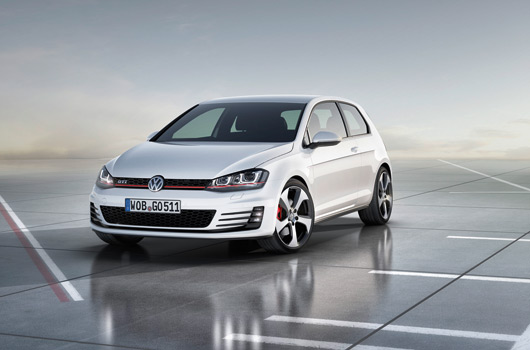
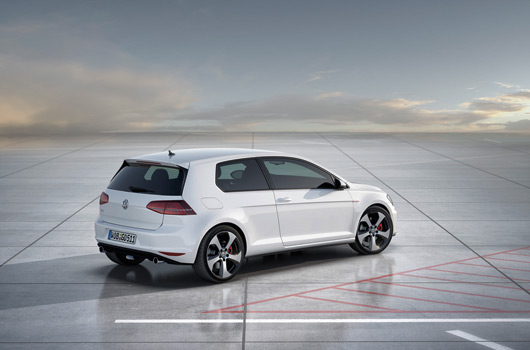
11 replies on “Paris 2012: Volkswagen Golf GTI concept”
Red stripe through the lights is great, the two power levels is just stupid. Poor form VW
Niiiiiiiiiiiiiiiiiiiiiiiiice.
Finally they saw the sense in getting rid of those awful wheels.
Looks nice, just a pity everyone and their mum will have one in 2 years.
Not a fan… despite alot of new parts including chassis and LSD, I just don’t like the look of the car.
I was really hoping for a high power upgrade, considering this is power output is still less than the mk5 pirelli/ed30!!!
However, it is the same engine as the new S3… so maybe great tuning potential.
[…] From the floor of the Paris Motor Show we bring you a selection of videos featuring the new Volkswagen Golf GTI concept. […]
[…] Volkswagen Golf GTI […]
I’d buy one. In fact I think I actually will. Tornado Red DSG with the ‘Glendale’ 18″ Alloys please.
As for the power increase complaint… Meh. They have to maintain a steady gap from R. Not to mention a Mk6 155 is already a pretty quick car. If you want more then take it to APR for a tune.
[…] showing off a Mk7 Golf GTI concept in Paris, Volkswagen is continuing the development and testing of its hero hot hatch, as these spy […]
[…] the 2.0 litre turbo engine from the Mk7 Golf GTI to be found under the bonnet when the Octavia RS hits the streets next […]
[…] The GTD follows the same proven path as the Mk6 model, whereby they’ve pretty much taken a new GTI and swapped over the 2.0 litre petrol engine for a turbo diesel of the same […]
[…] not really learning much more than we saw in Paris last year, but we can now confirm some details with greater clarity. The Golf VII GTI will be available in […]